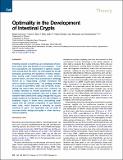Optimality in the Development of Intestinal Crypts
Author(s)
Itzkovitz, Shaul Shalev; Blat, Irene C.; Clevers, Hans; van Oudenaarden, Alexander; Jacks, Tyler E.; van Oudenaarden, Alexander; ... Show more Show less
DownloadItzkovitz-2012-Optimality in the De.pdf (1.086Mb)
PUBLISHER_POLICY
Publisher Policy
Article is made available in accordance with the publisher's policy and may be subject to US copyright law. Please refer to the publisher's site for terms of use.
Terms of use
Metadata
Show full item recordAbstract
Intestinal crypts in mammals are comprised of long-lived stem cells and shorter-lived progenies. These two populations are maintained in specific proportions during adult life. Here, we investigate the design principles governing the dynamics of these proportions during crypt morphogenesis. Using optimal control theory, we show that a proliferation strategy known as a “bang-bang” control minimizes the time to obtain a mature crypt. This strategy consists of a surge of symmetric stem cell divisions, establishing the entire stem cell pool first, followed by a sharp transition to strictly asymmetric stem cell divisions, producing nonstem cells with a delay. We validate these predictions using lineage tracing and single-molecule fluorescence in situ hybridization of intestinal crypts in infant mice, uncovering small crypts that are entirely composed of Lgr5-labeled stem cells, which become a minority as crypts continue to grow. Our approach can be used to uncover similar design principles in other developmental systems.
Date issued
2012-02Department
Massachusetts Institute of Technology. Department of Biology; Massachusetts Institute of Technology. Department of Physics; Koch Institute for Integrative Cancer Research at MITJournal
Cell
Publisher
Elsevier
Citation
Itzkovitz, Shalev, Irene C. Blat, Tyler Jacks, Hans Clevers, and Alexander van Oudenaarden. “Optimality in the Development of Intestinal Crypts.” Cell 148, no. 3 (February 2012): 608–619. © 2012 Elsevier Inc.
Version: Final published version
ISSN
00928674
1097-4172